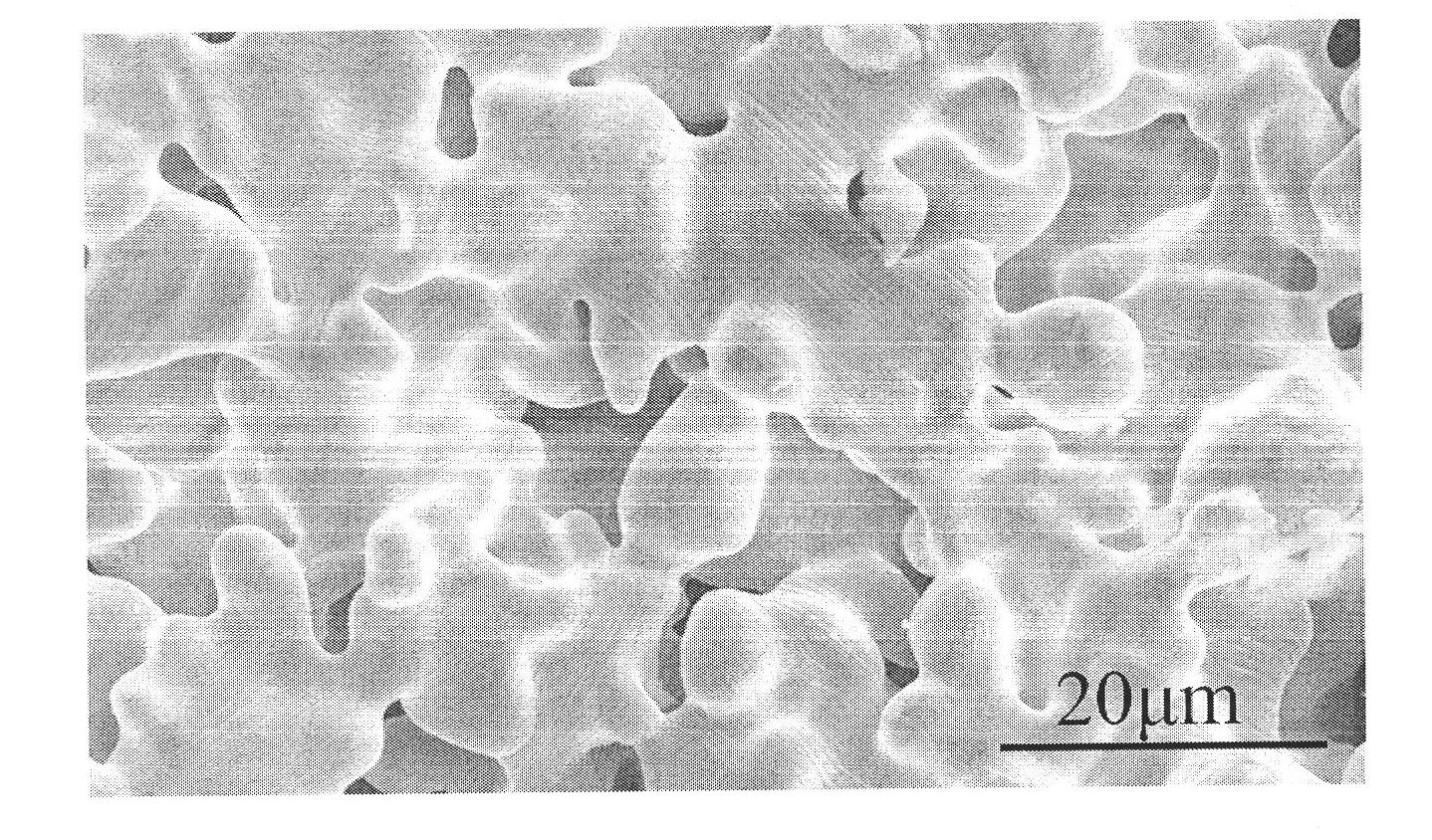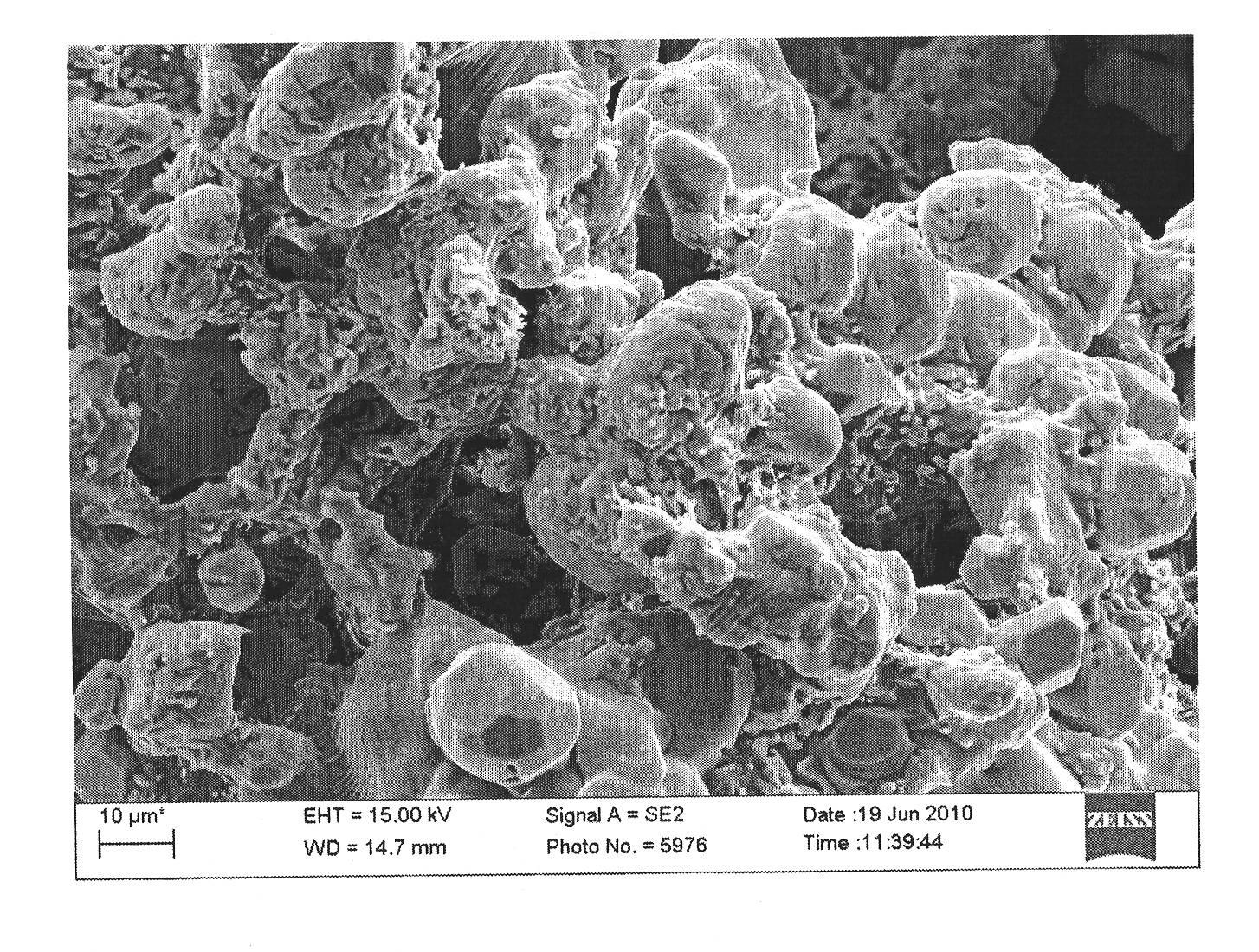Preparation method of gradient pore porous high-niobium titanium-aluminum alloy
A titanium-aluminum alloy and gradient hole technology is applied in the field of preparation of gradient hole porous high-niobium-titanium-aluminum alloy to achieve the effects of high yield, simple preparation process and low cost
- Summary
- Abstract
- Description
- Claims
- Application Information
AI Technical Summary
Problems solved by technology
Method used
Image
Examples
Embodiment 1
[0025] The first step: uniformly mix titanium, aluminum and niobium element powders in proportions of 50% (mass fraction, the same below), 40% and 10% respectively, the particle size of the titanium powder is 50um, and the particle size of the aluminum powder is 50um , the particle size of niobium powder is 12um;
[0026] The second step: 5 parts of mixed titanium aluminum niobium powder and NH 4 HCO 3 and polyethylene glycol were made into 5 sheet blanks, the pressing pressure was 50MPa, and the thickness was 1.5mm, of which NH 4 HCO 3 The contents are 46%, 40%, 31%, 25% and 11%, polyethylene glycol and NH 4 HCO 3 The ratio of 25:1;
[0027] The third step: According to the ratio of the amount of titanium, aluminum and niobium powder, five sheet-shaped blanks are sequentially stacked and regularized, and then rolled for the second time. The pressing pressure is 120MPa to obtain the total billet;
[0028] Step 4: Put the total billet into a vacuum drying oven and heat it...
Embodiment 2
[0031] The first step: uniformly mix titanium, aluminum and niobium element powders according to the ratio of 55%, 35% and 10% respectively, the particle size of titanium powder is 100um, the particle size of aluminum powder is 100um, and the particle size of niobium powder is 12um;
[0032] The second step: 5 parts of mixed titanium aluminum niobium powder and NH 4 HCO 3 and polyethylene glycol were made into 5 sheet blanks, the pressing pressure was 50MPa, and the thickness was 2mm, of which NH 4 HCO 3 The contents were 51%, 41%, 31%, 21%, 11% and 1%, polyethylene glycol and NH 4 HCO 3 The ratio of 25:1;
[0033] The third step: According to the ratio of the amount of titanium, aluminum and niobium powder, the 6 sheet-shaped billets are stacked sequentially and then rolled for the second time. The pressing pressure is 180MPa to obtain the total billet;
[0034] Step 4: Put the total billet into a vacuum drying oven and heat it to 110°C, and keep it warm for 2 hours to ...
Embodiment 3
[0037] The first step: uniformly mix titanium, aluminum and niobium element powders in proportions of 55% (mass fraction, the same below), 35% and 10% respectively, the particle size of the titanium powder is 10um, and the particle size of the aluminum powder is 5um , the particle size of niobium powder is 2um;
[0038] Step 2: Mix 3 parts of titanium, aluminum and niobium powder with NH by compression molding 4 HCO 3 and polyethylene glycol were made into three sheet blanks, the pressing pressure was 50MPa, and the thickness was 2.5mm, of which NH 4 HCO 3 The contents were 51%, 31% and 11%, polyethylene glycol and NH 4 HCO 3 The ratio of 25:1;
[0039]Step 3: According to the ratio of the amount of titanium, aluminum and niobium powder, the three sheet-shaped blanks are stacked in sequence, and then rolled for the second time. The pressing pressure is 200MPa to obtain the total billet;
[0040] Step 4: Put the total billet into a vacuum drying oven and heat it to 120°C,...
PUM
| Property | Measurement | Unit |
|---|---|---|
| Particle size | aaaaa | aaaaa |
| Particle size | aaaaa | aaaaa |
| Particle size | aaaaa | aaaaa |
Abstract
Description
Claims
Application Information
 Login to View More
Login to View More - R&D
- Intellectual Property
- Life Sciences
- Materials
- Tech Scout
- Unparalleled Data Quality
- Higher Quality Content
- 60% Fewer Hallucinations
Browse by: Latest US Patents, China's latest patents, Technical Efficacy Thesaurus, Application Domain, Technology Topic, Popular Technical Reports.
© 2025 PatSnap. All rights reserved.Legal|Privacy policy|Modern Slavery Act Transparency Statement|Sitemap|About US| Contact US: help@patsnap.com



